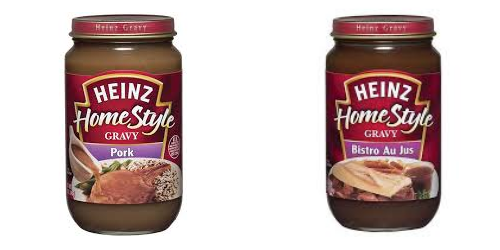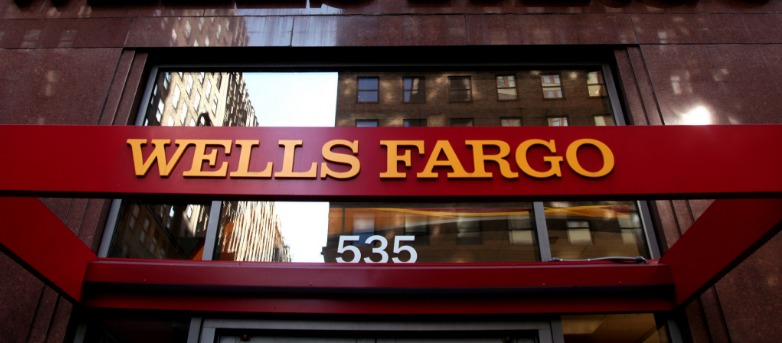Heinz Gravy Recall!! What in YOUR Jars?

Heinz has issued a voluntary recall on approximately 500 jars of gravy this week. According to the company, jars of the Heinz Pork Gravy may have actually been mislabeled as Heinz HomeStyle Bistro Au Jus Gravy. In addition to making for an interesting surprise during dinner, the mix up could possibly make some people with certain food sensitivities sick. Heinz Homestyle Bistro Au Jus Gravy contains milk and soy, whereas Heinz Pork Gravy does not.
If you’re concerned about the wrong gravy in your jars, just check the jar. The products affected are 12 oz jars labeled as Heinz Pork Gravy. The jars are labeled best by Dec. 28, 2017 with a UPC code of 013000798907.
If you find a jar of possible mislabeled gravy, you can return it to the store where it was purchased for a full refund or exchange. If ou have any other questions, you can call the company at (866)572-3808 from 9 a.m. to 6 p.m. Eastern Monday through Friday.
Wells Fargo Employees Caught Opening Unauthorized Accounts For Customers & Costing Them $2.5 Million in Fees

Wells Fargo is probably one of the most recognized banks in the United States, and for good reason. It is, by stock value, the biggest bank in the country. Many US citizens have been loyal Wells Fargo customers for years, and may even visit their local branch regularly. What was going on behind the counters in Wells Fargo banks, however, may have some loyal consumers pretty shocked and dismayed.
Last Thursday, regulators fined Wells Fargo Bank millions of dollars. The Consumer Financial Protection Bureau (CFPB) has socked the bank with the largest penalty the bureau has ever imposed at $100 million. The Office of the Comptroller of the Currency has also fined the bank $35 million, and the City and County of Los Angeles has imposed fines to the tune of $50 million. That’s a grand total of a whopping $185 million in fines.
According to the CFPB, Wells Fargo Bank employees were secretly opening unauthorized accounts in customers’ names without their knowledge. An analysis done by the bank itself showed that there may have been an estimated 1.5 million unauthorized deposit accounts opened in customers’ names. Another analysis showed that an estimated 565,000 credit cards were applied for without authorization from customers.Employees also issued and activated debit cards without consent or knowledge, as well as created fake emails to enroll customers in online-banking services.
The illicit activity cost customers an estimated $2.5 million in fees.
The purpose of these illegally created accounts may seem completely lost on most of us, but they did have a very clear purpose. Employees were attempting to meet the banks’ incentivized sales quotas. The employees were given credit for opening the new accounts and gaining more business for the bank.
This practice, known as sandbagging, artificially raised sales numbers. Employees were pressured to make sales quotas, or else they would end up working over to meet their goals. Some employees even feared losing their jobs if they continually fell short on their quotas. Bank managers even coached employees on how to inflate sales numbers, including how to find customers who were pre-approved for credit cards and issuing the cards without consent.
In addition to the fines, the CFPB has also ordered Wells Fargo bank to issue full refunds to affected customers, which the bank has already started to do. Wells Fargo Bank stated last Thursday that they have already issued 100,000 customers refunds, and $5 million has been set aside for this purpose. The bank is also required to hire an independent consultant to conduct a review of its procedures to ensure proper sales practices and possibly require employees to undergo ethical sales training. Over 5,000 Wells Fargo employees have already been fired since 2011 for unethical and improper sales practices.
I’d love to hear your thoughts on this, especially if you’re a Wells Fargo customer or employee! Sound off in the comments below!
Cows Slaughtered to Raise Milk Prices! 53 Million Dollar Payout for Some Consumers in Price-Fixing Lawsuit!

The price of milk and other dairy products is something that many families struggle with each and every week. And, it seems as though these prices just keep creeping higher and higher in some areas. Unfortunately, as consumers are now finding out, at least one of the reasons for rising dairy prices may be a bit more nefarious than we originally thought.
In order to raise the prices of dairy products like milk and cream, some farmers actually helped kill off dairy cows. Yep—you read that right! Dairy cows were being slaughtered, just so consumers—in the end—could pay more for milk! Because, of course, we don’t pay enough for it as it is.
This awful scheme was part of something called the herd retirement program, which was led by Cooperatives Working Together (CWT), a farmer led and funded cooperative run by the National Milk Producers Federation (NMPF). A lawsuit filed against CWT in September of 2011 claims that the cooperative illegally inflated milk prices by paying farmers to slaughter cows prematurely. Allegedly, the cooperatives paid above-market prices for dairy cows owned by the members. The cows were then sent to be slaughtered much earlier than they normally would have. Overall, roughly 500,000 cows are thought to have been slaughtered under this program.
Why, you ask? It’s Economics 101, folks. Supply and demand. When supply is low and demand is high, companies can charge more for a products. So, less cows means less supply, which drives up the prices of household dairy staples like milk and yogurt.
A US District Court granted preliminary approval of the $52 million settlement on August 25th, and the final approval hearing is slated for December 16th. This class action lawsuit could lead to a payout to certain consumers who bought milk, cream, half & half, yogurt, cottage cheese or sour cream from 2003 to the present. You must have been a resident of one of the following states from at least part of 2003 to the present:
- Arizona
- California
- Kansas
- Massachusetts
- Michigan
- Missouri
- Nebraska
- Nevada
- New Hampshire
- Oregon
- South Dakota
- Tennessee
- Vermont
- West Virginia
- Wisconsin
- Washington DC
Consumers who meet this criteria can find more information and submit their claims on BoughtMilk.com.
I don’t know about you, but I know that I find this price-fixing scheme disgusting and despicable! Buying milk and other dairy products is NOT cheap for my household either! It’s not unheard of for us to go through almost three gallons of milk each week, not to mention other dairy products like sour cream and yogurt.
Of course it irritates me that farmers and cooperatives are using underhanded methods of driving up prices on a household staple. That’s obviously pretty rotten. But, the absolute worst part of this awful scheme was the way that it was done. Hundreds of thousands of animals were slaughtered, and for what? Money! The bottom line, period. To me, that is simply unacceptable!
Unfortunately, that seems to be the way things are more and more these days. It’s all about the bottom line. The lives behind it all, the ones that make everything possible, are no longer important to the powers that be. It seems as if we are all expendable these days, people and animals alike, because all that matters is just that little bit of extra money in some fat cat’s pocket. Meanwhile, the regular folks on a budget are simply scraping to get buy.
So, yes—slaughtering hundreds of thousands animals so Americans can pay more for milk absolutely infuriates me!
